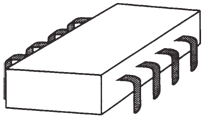Semiconductor capacitors:
These materials, in their several different forms, have revolutionized the electrical and electronic circuit design in past several decades.
These materials are employed to make capacitors. A semiconductor diode conducts current in 1 direction, and refuses to conduct in other direction. When the voltage source is connected across the diode such that it does not conduct, the diode behaves as a capacitor. The capacitance varies depending on how much of this reverse voltage can be applied to the diode. Greater the reverse voltage, smaller the capacitance will be. This makes diode a variable capacitor. Some of the diodes are especially manufactured to serve this function. Their capacitances rapidly fluctuate along with the pulsating direct current. These components are known as varactor diodes or simply varactors.
Capacitors are formed in semiconductor materials of the integrated circuit (IC) in the same way. At times, IC diodes are fabricated to behave as varactors. Another way to make a capacitor in the IC is to sandwich an oxide layer into the semiconductor material, between 2 layers which conduct well.
You have seen ICs in the electronic equipment; any personal computer has dozens of them. They look like small boxes having many prongs.

Figure-- An integrated-circuit package.
Semiconductor capacitors generally have small values of capacitance. They are small physically, and can handle low voltages only. The advantages are miniaturization, and the ability, in the case of varactor, to change in the value at a fast rate.